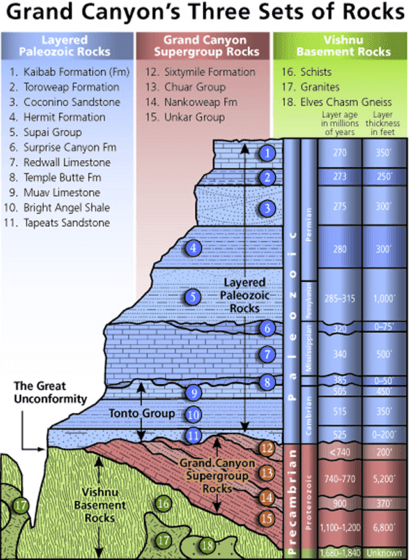Great Unconformity facts for kids
The Great Unconformity is a fancy name for a huge gap in the layers of rock on Earth. Imagine a book where many pages are missing – that's what an unconformity is in geology! It means a long time passed, and rocks were formed, then worn away, before new rocks were laid down on top.
Two famous examples of the Great Unconformity are found in Scotland and the Grand Canyon in the United States. Both show amazing evidence of how mountains can rise up and then be worn down over millions of years.
Contents
What is an Unconformity?
Rocks are usually laid down in layers, one on top of the other, like pancakes. This is called stratification. An unconformity happens when there's a break in this layering. It means that for a long time, no new rock layers were formed, or existing layers were worn away by erosion.
These gaps show us that the Earth's surface is always changing. Areas that were once low and collecting sediments can be pushed up to form mountains. Then, wind, water, and ice wear these mountains down. Later, the land might sink again and get covered by new sediments. The "Great" unconformities are special because they cover huge areas and represent incredibly long periods of time. They often relate to big events like continents crashing together or global changes in sea level.
Hutton's Great Unconformity in Scotland
One of the first people to understand these gaps was James Hutton in 1787. He saw a clear example at a place called Siccar Point on the coast of Scotland.
At Siccar Point, you can see two very different sets of rocks. The bottom rocks are grey and stand almost straight up. They are about 425 million years old. On top of them are reddish rocks that lie almost flat. These top rocks are about 345 million years old.
This means there's a gap of about 80 million years! During that time, the bottom rocks were turned into solid stone, folded and tilted by huge forces, lifted up, and then worn down by weather. Finally, new rivers and streams laid down the reddish rocks on top. Hutton realized this showed the Earth was much, much older than people thought at the time.
Powell's Great Unconformity in the Grand Canyon
Another famous example of the Great Unconformity was seen by John Wesley Powell in the Grand Canyon in 1869. This unconformity is found across a huge part of North America.
In the Grand Canyon, this gap separates the younger, flat-lying Tonto Group of rocks from much older rocks below. These older rocks include the tilted layers of the Grand Canyon Supergroup and even older, very hard rocks called the Vishnu Basement Rocks.
The time gap here is truly massive!
- Between the Tonto Group and the youngest Grand Canyon Supergroup rocks, there's a gap of about 175 million years.
- Where the Tonto Group sits directly on the Vishnu Basement Rocks, the gap can be as much as 1.2 to 1.6 billion years! That's a mind-boggling amount of time.
This huge gap shows a long period when ancient North America was lifted up. During this time, a lot of rock was worn away before a shallow sea covered the land and new sediments were laid down.
A Great Unconformity in Nevada
You can also see a clear example of Powell's Great Unconformity at Frenchman Mountain in Nevada. Here, the 550-million-year-old Tapeats Sandstone (part of the Tonto Group) sits right on top of 1.7-billion-year-old Vishnu Basement Rocks. This means there's a gap of about 1.2 billion years! It's a great place for scientists and students to see this amazing geological feature up close.
Why are there so many Unconformities?
Scientists have noticed that many unconformities, especially those involving the very oldest rocks, appear just before the Cambrian period (about 541 million years ago). Charles Doolittle Walcott, an early geologist, pointed this out in 1910. He said that everywhere he looked in North America, there was always a gap between the older rocks and the Cambrian layers.
Scientists are still trying to figure out exactly why these huge gaps exist. One idea is that massive Snowball Earth glaciations, which covered almost the entire planet with ice around 1 billion years ago, played a role. As glaciers move, they scrape away huge amounts of rock and sediment. This could explain how large sections of rock were removed from widespread areas around the same time.
Another idea is that many smaller events, like the formation and breakup of ancient supercontinents (like Rodinia), created many unconformities around the world. It's likely that a combination of these big events caused the Great Unconformity we see today.
Images for kids



